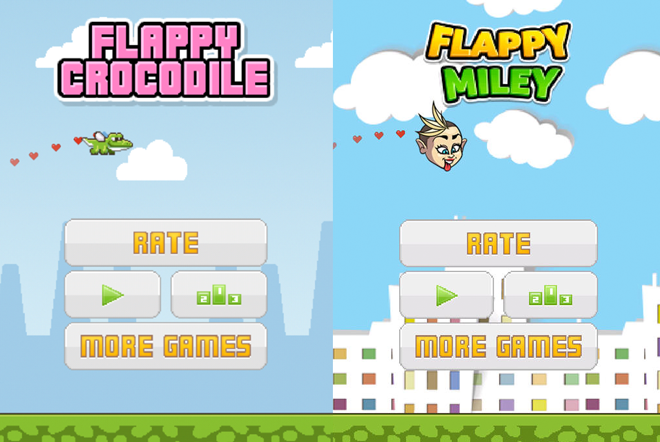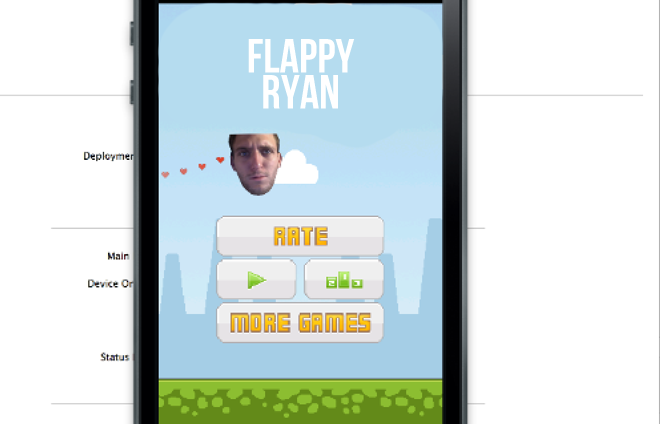
09/04/2014
You don’t need to be a programmer to break into the App Store’s top charts. All you need is 100 bucks and a free afternoon.
You’ll need a halfway decent idea, of course, but once you’ve got that nailed down, you can easily buy the source code, get an online tutorial on how to use it and within hours have a game ready to play. That explains why 95 of the 300 or so new apps released on Apple’s iTunes store one day last week were riffs on Flappy Bird, the mega-hit its creator pulled at the height of its popularity. There’s Flappy Wings, Splashy Fish, even Crappy Bird.
For some reason, a surprising number of these apps, like Flying Cyrus, Cyrus Flyer and Jumping Miley, feature the disembodied head of pop star Miley Cyrus. One of the most downloaded of this unlikely sub-genre is Flappy Miley Wrecking Ball Pro, created by Gregory Storm. He uploaded the game on February 12, just two days after Flappy Bird flew the coop. Never mind that he’d only heard of Flappy Bird the week before. “I had no idea what a Flappy Bird was,” Storm said. “Never played it. Hadn’t seen it.”
So how was he able to create Flappy Miley so quickly? Easy: He bought everything he needed.
The first step was purchasing the source code to Flappy Crocodile.
On sites like Chupamobile, billed as “a stock photo agency, but for app development,” programmers can sell their app’s source code to others. This is hardly a new idea in the videogame business, but just as the democratization of development has allowed people to create games with small budgets and sell them at low prices, so too has it created a market where middleware mavens can sell source code to would-be developers for next to nothing.
Want to clone Bejeweled? The rights to the source code are just a few clicks away.
You need an app for your restaurant? Chupamobile has templates for $50 each. Want to create a match-three game like Bejeweled? A clone of Tiny Wings? The rights to the source code are just a few clicks and a few bucks away. Just $99 gets you an open-ended, royalty-free license to use the Flappy Crocodile code to create a single app and sell it in perpetuity. Even if you make a million bucks, you don’t owe another cent to the guy who did the heavy lifting.
In the case of Flappy Crocodile, that guy is Vojtech Svarc, a 26-year-old app developer from the Czech Republic. He’s spent the past six years jumping from one online business to another: website scripting, e-books, Google AdSense and practically everything else. Svarc got into the app business about a year ago, but quickly realized that investing large amounts of cash into a single app and hoping it would be discovered among the 1 million or so already on the App Store might not be the best use of his time. Then he thought, what if building an app could be more like building a website? “When building a website, there is no need to start from scratch as there [are] plenty of templates out there to choose from,” Svarc said. “Using templates cuts the cost and time down, and it allows you to get your products out there quickly.”
“When building a website, there is no need to start from scratch as there [are] plenty of templates out there to choose from,” Svarc said. “Using templates cuts the cost and time down, and it allows you to get your products out there quickly.”
Svarc watched the App Store and noticed that any time an app made waves, similar apps would be buoyed to the top. Speed, he thought, was key to taking advantage of that. App templates would allow developers to build trendy apps in no time. “When I saw the media attention Flappy Bird was getting,” Svarc said, “I knew this [was] a ride I need to be on.”
So far, he says, about 100 developers have paid him $100 each to use Flappy Crocodile. Svarc says Tiny Flying Drizzy, which was the No. 1 free game on the App Store earlier this week, is based on his engine.
Anyone with a C-note and ten seconds can license the source code to a videogame. But what do you do then? Don’t you need programming skills to actually modify the code?
Nope. You don’t need any special skills at all. To prove it, I bought a license to use Flappy Crocodile.
I’ve worked on a mobile game before, but I’m a terrible programmer. Still, I could see that my $100 had bought me a complete package: Svarc had included every asset, function and plugin you’d need to publish and sell a Flappy Bird clone. It also included a voucher for an online course, led by Svarc and app developer Yohann Taieb, that walks you through the process of creating your first app. It covers everything from registering for an Apple developer license to reskinning the graphics and adding in-game advertising to uploading your finished product.
I had a little trouble setting things up properly at first because of how I’d set up the open-source game engine Cocos2d while developing my own apps. With a little adjustment I had Flappy Crocodile running smoothly in Xcode, Apple’s iOS development software.
With minimal effort and zero coding required, I could now start replacing any of the game’s art or sound with my own files. A drag and a drop later, Flappy Crocodile’s cheery background song became “Type of Way” by Rich Homie Quan.
Then I found the folder containing the files for animating the crocodile. I opened up Photo Booth and snapped a selfie, cut out my head using Photoshop, then replaced the crocodile sprite with my face. I compiled the new code, feeling more than a little surprised when the iPhone simulator launched successfully, allowing me to direct my own head through a gauntlet of pipes. In less than an hour, I’d changed Flappy Crocodile into Flappy Ryan.
Gregory Storm put more spit and polish into his clone than I did.
“My wife knew an awesome animator named Reinaldo Rocha,” he said, “and he was able to get us preliminary sketches within an hour.” Storm swapped in Rocha’s drawings of Cyrus, which featured flapping ears and a tongue that is forever sticking out.
Now I can buy a standardized solution for the price of a pizza.
He made several other tweaks before submitting the game to the App Store, all of them minor: The static background image is different, and all the sound effects have been changed. Otherwise, everything from the menus to the pipes are straight from the source code. Some app templates require users to “re-skin” everything, from the graphics to the music to the sound effects, before they upload the app. Flappy Crocodile‘s license agreement has no such restrictions.
Assembling an app using inexpensive source code and zero knowledge of programming is limited to simple app games today, but it won’t be long before you can use the same trick to build more elaborate games. There’s already a similar sharing economy where developers use the low-cost game development engine Unity. And anyone can buy complex elements of game design like artificially intelligent enemies. Buy the code, slap it into your game, and you’re done.
“Things like rendering a silhouette when the player moves behind an obstacle, or handling palette swapping characters, used to be done on a game-by-game basis. Now I can buy a standardized solution for the price of a pizza,” game developer Mike Bithell said in a blog post on the Unity website.
It takes significantly more effort to create a high-quality game in Unity than it does to whip out a Flappy Bird clone, but we’re reaching the point where non-coders will be able to make increasingly complex games and throw in snazzy features as easily as ordering an extra large with pepperoni. More and more popular indie and mobile games have begun using Unity in recent years — République, Plague Inc. and Rust, to name just a few — and this is one of the reasons.
The widespread availability of source code and templates is just putting small developers on par with big players in the app market, says Storm. Big Fish Games, he notes, has published more than 100 hidden object games on the App Store.
“I highly doubt they build from scratch for every new title,” Storm says. “They aren’t trying to be original and recreate the wheel. They’re trying to maximize their proven formulas and repeat them by re-skinning and using the same source code over and over.”
Creating such games, he says, is like appearing on the cooking competition show Chopped. “Everybody has the same basket full of odd ingredients and you have a short time to make something tasty with them or you’ll lose out,” Storm says. “It’s my job to take the same source code that everybody else has been given and spice it up.”
Still, with so much competition it isn’t easy for a guy like Storm to make a killing. With all of his costs — buying the art, hiring a freelance programmer to help with updates, etc. — he says he’s spent about $2,500 creating Flappy Miley. If it sticks around — say, if Miley Cyrus twerks her way back into the news — Storm could rake it in. But in the volatile app marketplace, that’s a big “if.”
“At this point we’ve just about made our money back,” Storm says, “so it looks like a fun night at the Olive Garden is in our future.”
Fonte: wired.com

BrD Consulting è iscritta all'Albo Aderenti Assofranchising e ne osserva il Codice Etico.